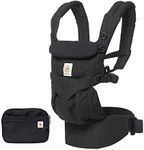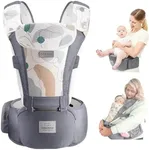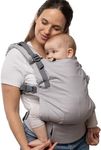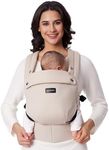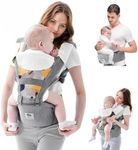Buying Guide for the Best Baby Carriers With Back Support
Choosing a baby carrier with back support is an important decision for both your comfort and your baby's safety. The right carrier can make outings easier, keep your hands free, and help you bond with your baby. When shopping, focus on how the carrier distributes weight, how adjustable it is, and whether it fits your body type and lifestyle. Always consider your baby's age and size, and make sure the carrier supports healthy hip and spine development. Trying on different styles, if possible, can help you find the most comfortable fit for both you and your baby.Back Support DesignBack support design refers to how the carrier is structured to support your lower and upper back while carrying your baby. This is important because carrying extra weight for long periods can strain your back, leading to discomfort or even injury. Some carriers have padded lumbar support, wide waistbands, or structured frames. If you plan to carry your baby for extended periods or have a history of back pain, look for carriers with firm, adjustable lumbar support and wide, padded straps. For shorter outings or lighter babies, a simpler design may be sufficient.
Weight DistributionWeight distribution is about how the carrier spreads your baby's weight across your body. Good weight distribution reduces pressure on your shoulders and back, making it easier to carry your baby comfortably. Carriers with wide, padded shoulder straps and a supportive waistband tend to distribute weight more evenly. If you have a heavier baby or plan to use the carrier for long walks, prioritize models that distribute weight to your hips and lower back, not just your shoulders.
AdjustabilityAdjustability means how well the carrier can be customized to fit different body shapes and sizes. This is important because a well-fitted carrier is more comfortable and safer for both you and your baby. Look for carriers with adjustable straps, waistbands, and seat positions. If more than one person will use the carrier, or if you want it to grow with your baby, high adjustability is key. Try to choose a carrier that can be easily adjusted while wearing it, so you can make quick changes as needed.
Carrying PositionsCarrying positions refer to the different ways you can wear your baby in the carrier, such as front-facing in, front-facing out, hip carry, or back carry. This matters because your baby's age, size, and developmental stage will affect which positions are safe and comfortable. For newborns, front-facing in is usually best, while older babies may enjoy back or hip carries. If you want a carrier that will last through different stages, look for one that offers multiple carrying positions.
Breathability and MaterialBreathability and material describe what the carrier is made of and how well it allows air to flow. This is important for keeping both you and your baby comfortable, especially in warm weather or during long outings. Some carriers use mesh panels or lightweight fabrics for better airflow, while others use thicker, more padded materials for extra support. If you live in a hot climate or plan to be active, choose a carrier with breathable materials. For cooler climates or extra comfort, a more padded carrier may be preferable.
Ease of UseEase of use refers to how simple it is to put on, adjust, and take off the carrier. This is important because you’ll often be handling your baby alone, and a complicated carrier can be frustrating or unsafe. Some carriers have buckles and clips, while others use wraps or ties. If you’re new to babywearing or want something quick for errands, look for a carrier with straightforward buckles and clear instructions. If you enjoy a snug, custom fit and don’t mind a learning curve, wraps or more complex carriers might work for you.
Support for Baby’s Hips and SpineSupport for your baby’s hips and spine is about how the carrier holds your baby’s body, especially their legs and back. This is crucial for healthy development, as improper support can lead to hip or spine issues. Look for carriers that keep your baby��’s legs in an 'M' position, with knees higher than their bottom, and that provide firm support along the back. If your baby is a newborn or has special health considerations, prioritize carriers that are certified as 'hip-healthy' by recognized organizations.
